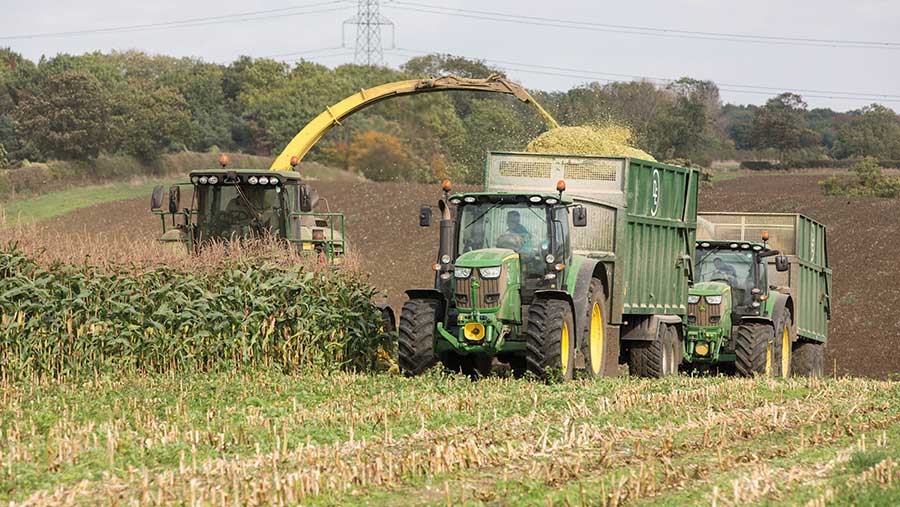Maize Watch 2022: Advice for a safe maize harvest
 © Tim Scrivener
© Tim Scrivener The return of rain showers means maize growers should plan their harvest to ensure the safety of the contracting team and other road users, recommends Neil Groom of forage specialist Grainseed.
“Now most areas of the country have seen some autumn rains, fields have started to wet up and soil will be deposited on to public roads as trailers haul the silage back to the farm,” he says.
See also: 3 ways to get the best results from maize crops
Mr Groom advises taking the following measures:
- Use a sweeper to keep the road clean and display warning signs so drivers are aware of the increased risk
- Plan a route for the trailers in advance, creating a circuit on small lanes so that trailers do not have to pass each other and there is an efficient flow from field to clamp
- If possible, use farm tracks coming out of maize fields so wheels are clean of soil before accessing the public road
- Ensure all staff wear hi-vis clothing and have proper breaks
- When working in darkness, take extra care, especially in the clamp where trailers and the buckrake are moving continuously.
Winter feed supplement
Rain showers and warm seed-beds are encouraging growers to drill Westerwolds, Italian ryegrass and grazing rye to supplement winter feeding, says Mr Groom.
He advises cutting the maize low, running a cultivator tine through the soil to remove any surface compaction, and then drilling shallowly or broadcasting and rolling the seeds in.
Rolling will help destroy the maize stumps over winter.
If these areas are going to be drilled with maize next year, he advises early spring grazing over a silage cut, or very early cutting.
“We don’t want to utilise all the winter rainfall producing a big silage crop, and then have to rely on spring rains to germinate the maize seedlings.”
Progress of maize crops on six sites in England, Scotland and Wales, 2022 growing season |
||||
|
Site |
Drill date |
Height above sea level (m) |
Crop dry matter 6 September |
Increase from last week |
|
Petworth, Sussex |
26 April |
50 |
Harvested |
|
|
Harleston, Norfolk |
29 April |
30 |
38.4% |
6.3% |
|
Crediton, Devon |
27 April |
118 |
25.0% |
0.9% |
|
Ticknall, Derbyshire |
26 April |
67 |
Harvested |
|
|
Narbeth, South Wales |
3 May |
32 |
24.3% |
3.4% |
|
SRUC, Dumfries, Scotland SAMCO Film |
22 April |
45 |
24.6% |
0.8% |
|
Variety: Es Tommen. Variety under film: Cathy Source: Grainseed |
||||
Case study: Maize Watch grower Toby Tibbenham
Farm facts – Weybread Hall, Suffolk
- 245 autumn-calving Holsteins
- Growing maize on 45ha (110 acres) along with 30ha (74 acres) grass silage leys as break crops in the arable rotation on higher land
- Spring and summer grazing on permanent pasture in river valley
- Varied soil type, but predominantly medium clay loam
Despite the summer drought, Toby Tibbenham’s forage maize crop at Weybread Hall on the Norfolk/Suffolk border looks “all right”.
He expects the overall yield from the 45ha (110-acre) field down to the crop this year to be below average – probably by about 25% – but dry matter (DM) will most likely be only 1-2% above the usual 33% mark.
Mr Tibbenham has been sampling his crop for Maize Watch (see table). “We did see the DM did shoot up last week, but I think, looking at the field as a whole, we’ll be about right – about 34 or 35%,” he says.
Early harvest
Cutting began on Monday (12 September). “A bit of the leaf was getting quite dead, but there was still some milkiness in the cob, so we left it until today,” he says.
“It’s an early harvest – we would normally be cutting in two to three weeks’ time – and we’re probably at the end of cutting around here. A lot of people have already cut theirs,” he says.
Having produced a surplus of maize silage for the farm’s 245 Holsteins last year, Mr Tibbenham reduced the area grown this year. In hindsight, he says, given the drought, he would have been better keeping it the same.
“We would usually expect a yield of about 40t/ha, and I think we’ll be looking at closer to 30t/ha this year,” he predicts. However, he is not concerned about a shortage of forage this winter and has the option of growing some wholecrop next spring.
Cover crop
Slightly heavier soils will have retained more moisture than some in the area, Mr Tibbenham reckons. A cover crop of grass, stubble turnips and forage rape sown after wheat last autumn and before drilling maize may also have helped.
Before sowing the cover crop, part of the field was cultivated before drilling, and part of it left uncultivated.
The cultivated part lost more moisture, and here, establishment of the stubble turnips was only 50% or less, but the grass established quite well.
Where the ground was undisturbed, the stubble turnips and forage rape did well, and the grass less so.
“We ended up with two different types of cover crop,” says Mr Tibbenham. “I don’t think there’s much difference across the field in terms of the maize – but we don’t have a yield mapper on the forager, so I can only judge by eye.”
The cover crops were grazed off with fattening lambs, and once lambs they had gone in the spring, the field was mucked, cultivated, and drilled with maize.
“You’re not going to get rich off fattened lambs, but they covered the cost of the cover crop, we haven’t had to plough or leave bare soil over the winter, and the cover crop mopped up residual nitrogen from the wheat crop,” he says.
